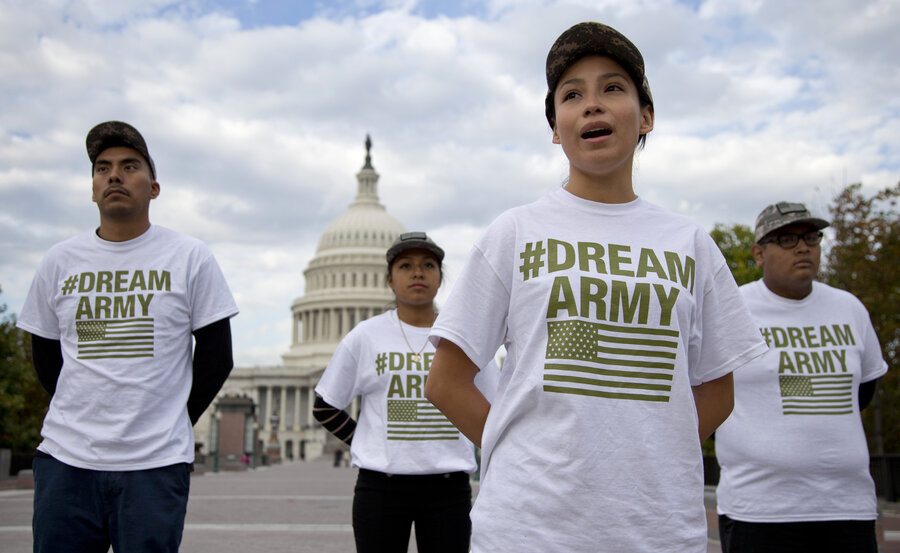In Mexico, momentum grows to put out welcome mat for 'Dreamers'
Loading...
Before Maggie Loredo left her home in Georgia’s Dalton County for her grandfather’s house in San Luis Potosí, Mexico, she called the office of the Mexican public education secretariat.
If I want to apply to a public university, she asked, but I grew up in the United States, which documents am I going to need?
Nothing but your transcripts and diploma, the attendant told her.
At the time, in 2008, that sounded alluringly simple to Ms. Loredo, who had lived without legal status in the US since she was a toddler. She was contemplating a dramatic remedy to her stagnating work life: a move to the forgotten country of her birth, where public college is free and no immigration-related work rules would crimp her career aspirations.
What she found upon her return was a different story.
After several visits and phone calls to the secretariat, she finally tracked down the person who could revalidate – certify as authentic and applicable to Mexican standards – her high school education.
"I took all my papers and showed them to [him]," she says. "He was like, 'No, this is not going to work.' "
The actual requirements ended up being a tall (and expensive) task for Loredo, who put off college for a number of years. Like many US-raised Mexicans who want to continue their educations in Mexico, she grew discouraged by both bureaucratic indifference and laws requiring a wealth of paperwork from back in the US.
But for several years, Dreamer activists like Loredo, now an interpreter and co-founder of Otros Dreams en Acción, or Other Dreams in Action, have lobbied for reforms: for example, eliminating the requirement that high school graduates provide documentation for every grade level completed outside of Mexico, along with a US state-granted apostille, or certification.
And Mexico is starting to move on the issue. In a speech earlier this month, President Enrique Peña Nieto promised an “almost automatic revalidation" to returning Dreamers. And the Mexican Senate’s education committee, along with the public education secretariat, are working on details of a plan that is expected to easily pass the chamber.
Activists estimate nearly half a million Dreamers between the ages of 18 and 35 returned to or were deported to Mexico between 2005 and 2014. Not all of this population has sought access to higher education. But the sub-secretary for higher education, Salvador Jara Guerrero, estimates that some 40,000 could arrive in coming years looking to attend college here. Universities see Dreamers as a group raised in a comparably rigorous educational system. Politicians see them as useful for growing international business ties – and for the patriotic "optics."
“I think the reason why we’re seeing this right now and not before is because the 'Trump situation’ gives a very good opportunity for politicians who have eyes on the election of 2018” and are eager to be seen pushing back against the US president, says Eileen Truax, a Los Angeles-based journalist who has covered Dreamer issues for more than a decade.
Early details of the plan, however, have provoked dismay from many longtime activists, who say the law is being tailored to a handful of the most "competitive” transfer students from a short list of prestigious US universities, leaving obstacles in place for the majority who return with a high-school education, GED, or credits earned at community colleges.
"As a proposal with political purposes rather than of real help for returned and deported people, what is being sought is fast-track approval, without giving the time or conditions necessary for dialogue, analysis and understanding," wrote researchers Nancy Landa and Fredi García Alverdin, in an Feb. 20 editorial.
Mexico's public universities, inspired in part by a letter signed by more than 600 US university presidents urging Trump not to eliminate deportation protections under the Deferred Action for Childhood Arrivals (DACA) program, have started looking into ways they can accommodating a possible surge in returned and deported Dreamers. At least one private university, the prestigious Universidad Iberoamericana, is pledging a full scholarship for up to 1,500 Dreamers who are accepted.
Figuring out how to transfer US university credits for the purposes of a licenciatura, the rough equivalent of a bachelor's degree, could be particularly thorny, says Rosa Graciela Montes, director of the Center for International Education at the public Benemérita Universidad Autónoma de Puebla (BUAP).
At present, the Secretariat of Public Education is responsible for that. Advocates want to let Mexican universities set their own standards for transferring college credits earned in the US, though some university administrators warn it could be a step toward the "commercialization" of educational services.
But some universities with past experience in dealing with Dreamers' needs are drawing up plans aimed specifically at their inclusion. At the BUAP, for instance, a cultural-exchange program that hosted about 100 Dreamer visitors last summer is being reinvented into a linguistic program to train newcomers in academic Spanish.
And it is also hoping to ease Dreamers' social transition into a place that has not always proven especially tolerant of US-raised Mexicans' linguistic and cultural differences, says Dr. Montes, through "Big Brother, Little Brother"-style mentorship programs.
Given the intensely competitive admissions for public universities, that part of the BUAP's efforts could be especially important if Mexico's current economic crisis worsens and gives rise to more nativist feelings.
"It's going to be a big shock," she says. "We are thinking it's not just a question of accepting them back but trying to promote their inclusion. So we have to do a lot of work within the university population to raise consciousness about the problems that these incoming, returning students would face here.
"We just have to really work hard to make very clear guidelines for admission procedures, without putting extra hurdles for other students, to meet what will probably be a crisis over the next couple of years."








